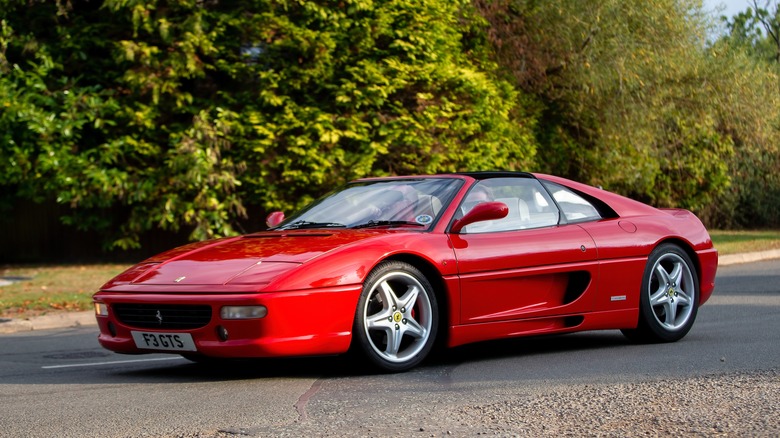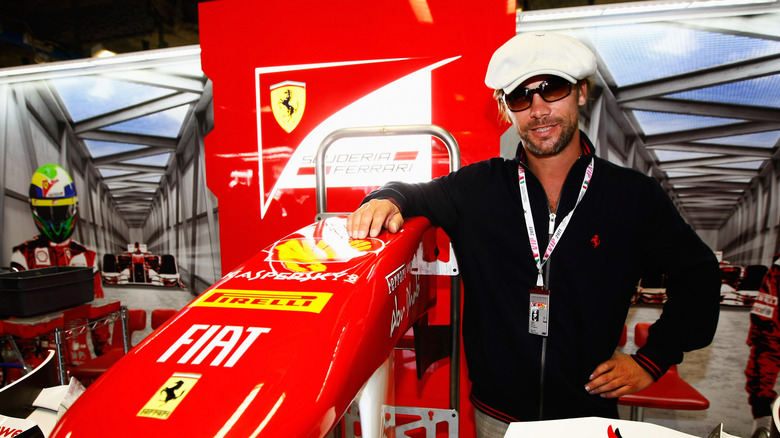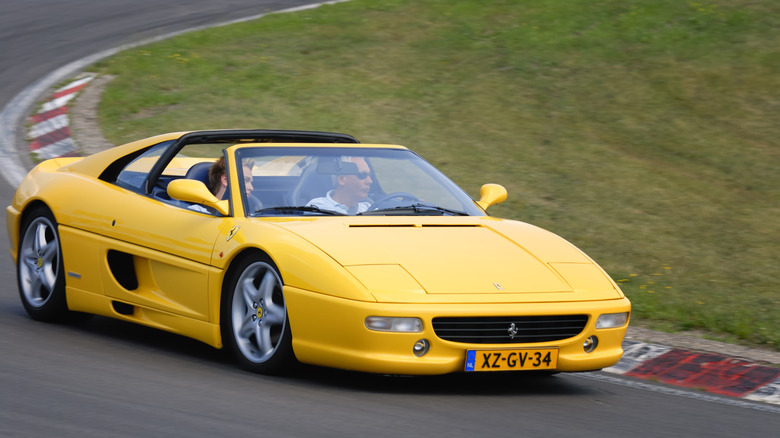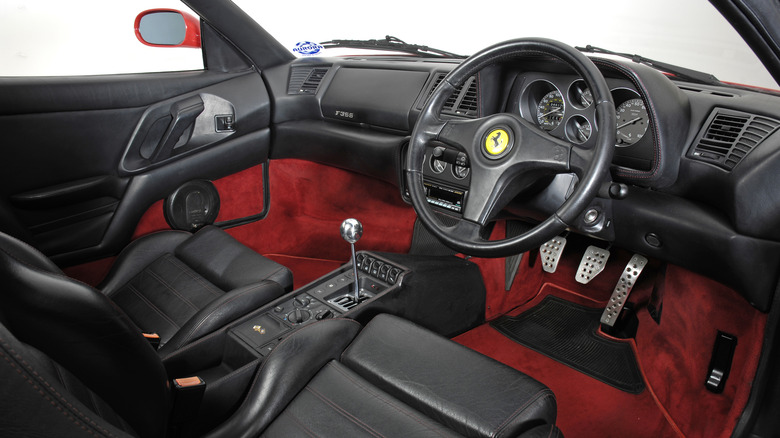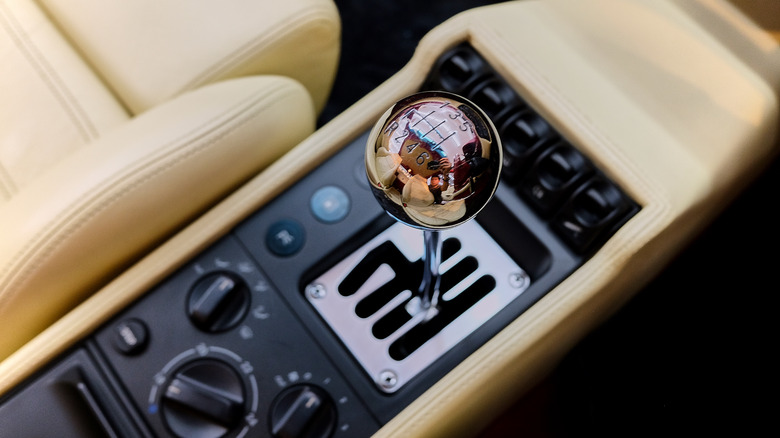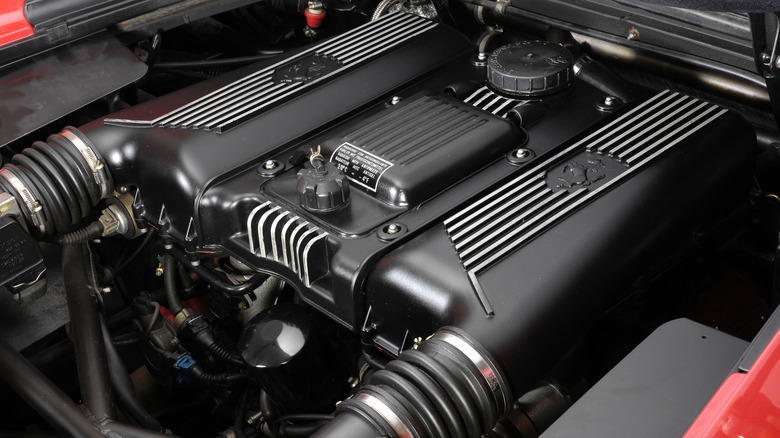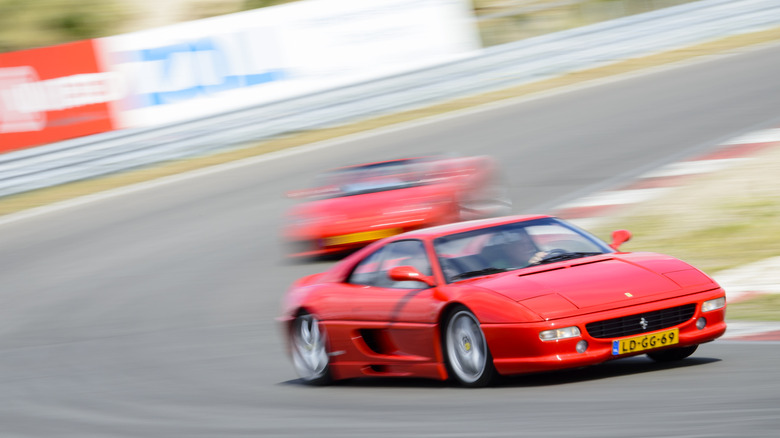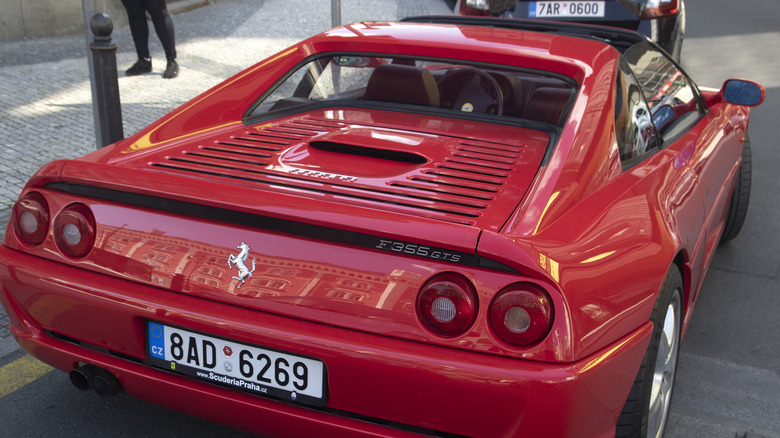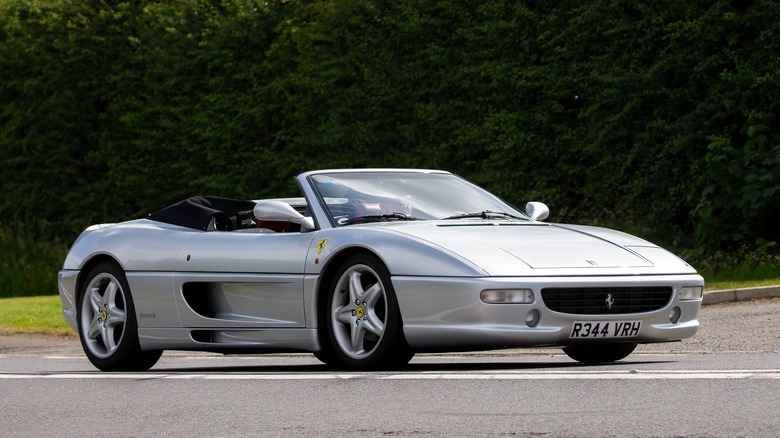Why The Ferrari F355 Is One Of The Greatest Supercars Of All Time
Ferrari is one of the great Italian automobile marques that need no introduction though the excellent Ferrari F355, with its storied history and quirky characteristics, is certainly worthy of a few words. It came about after the 1980s when car designs were as angular as the shoulder pads and haircuts adorned by their drivers. But before the mid-1990s when new technologies such as racing transmissions and electronic assists began to sterilize the driving experience. And while Ferrari had a very successful run in the '80s, having produced models like the iconic Testarossa, and lightning-quick F40, the brand was starting to falter as the 1990s loomed with lukewarm offerings such as the overly-sensible 412 and the uninspiring 348 GTB.
Ferrari needed something with an extra "wow" factor to restore its reputation as the most stylish and aspirational car company on the planet. A modern icon for the new decade that could showcase supercar performance while retaining some practicality for real-world usage. With that, the dependable folks at Pininfarina, the company that had designed Ferraris since 1951, got to work. And in 1994, the Ferrari F355 was introduced. It looked like a softened Testarossa, with its buttressed rear window and pop-up headlights, but minus the aggressive side strakes and jutting rear, instead opting for a more modern, sculpted profile.
The F355 was available in three styles — a coupe known as the Berlinetta, a Targa-top (the GTS), and, later, a convertible (the Spider). While each iteration had its supporters and detractors, the car was, on the whole, a great success. It was to become the defining Ferrari of its era and is still much-celebrated 30 years later. But what exactly made this one of the greatest supercars of all time?
It has plenty of star appeal
A good yardstick as to the desirability of a supercar is its star appeal, from Lamborghini Miura P400 owners such as Frank Sinatra and Rod Stewart to the Porsche 911s of Jerry Seinfeld and Jay Leno. But the brand with arguably the most famous supporters is Ferrari. The F355 has attracted all manner of celebrities, including sports stars, movie stars, musicians, and motoring journalists. It has even enjoyed a place in cinematic history as the yellow model that was raced by Nicholas Cage's character "Goodspeed" through the rolling streets of San Francisco in "The Rock." Despite Michael Bay's split-second cuts, the car stands out as the star of the sequence, even as it trails Sean Connery yelling exclamations from a Humvee.
Famous owners of the F355 include basketball legend Shaquille O'Neal, who bought one mid-way through his tenure with the Lakers in the late 1990s, at the peak of his career. This was a rather unique example, as a regular F355 would be hard-pushed to accommodate Shaq's over 7-foot, 320-plus pound frame. As such, this silver 1998 Spider underwent a significant overhaul. It included a custom hood, relocated fuel tank, and body modifications to better suit the man-mountain. Plus, some aftermarket goodies to add a little pizzazz befitting a sporting superstar.
Other famous owners include renowned car enthusiast and "Jamiroquai" band leader Jay Kay, who had a racing-focused F355 Challenge; motoring journalist and "Top Gear" presenter Jeremy Clarkson, who owned a GTS and knows a thing or two about cars; and perhaps most impressive of all, seven-time Formula One racing champion Michael Schumacher, who drove for Ferrari during the 1990s and 2000s, and who also owned a GTS at a time when he could have had any Ferrari he wanted.
An exterior for a new era
The design of the Ferrari F355 occupied a sweet spot in automotive history that fell between the boxy, wedge-shaped cars of the 1980s and the overly-sculpted bodywork of the 2000s. As a result, the F355 could be seen as one of the last Ferraris of the classic era, and it was the last model to be hand-built at its Modena factory. It represented a fitting tribute to the end of the century that saw Ferrari established in Maranello, Italy, in 1947.
Like its predecessor, the 348 GTB, the F355 featured a pressed-steel monocoque body with aluminum and steel body panels. No composite Kevlar or carbon fiber was used in its construction as with other supercars, including Ferrari's own F40. With the F355, Ferrari was going back to basics with its manufacturing methods, materials, and design characteristics, resulting in an unpretentious car with clean lines, tasteful intake ducts, and understated spoilers.
Whether you opted for the Berlinetta, GTS, or Spider variant, each was a beautiful car in its own right. Ferrari went the extra distance to make sure that its lines were uninterrupted by including pop-up headlights and even going so far as to hide the door handles inside the side strakes, which were not as prominent as on the Testarossa and its successor, the TR512. It seemed that after the excesses of the 1980s, Pininfarina had mellowed and wished to make a more mature car that was as serious about driving as it was about turning heads.
An uncluttered interior
The interior of the Ferrari F355 is a fine example of the minimalist-yet-flamboyant style that the brand used to do so well. Starting with its features, there is little to distract the eye here, with its plain dash that comprises an integrated glove box and a few air vents. The central instrument panel is limited to a single-DIN stereo and three analog gauges (for its clock, fuel level, and oil temperature). Meanwhile, the main instrument panel presents four analog dials, including a speedometer, tachometer, oil pressure, and engine temperature gauges. Its appeal lay in its simplicity, and it almost makes you sentimental for a time before touchscreens, Apple CarPlay, and in-car GPS, when the focus was on driving and nothing else.
For all the F355's technological minimalism in the cockpit, the furnishings leave you with no doubt that you are driving a Ferrari. Those who dislike the use of animal products as decoration should be aware that there is more cow adorning the F355 than can be seen at a Dallas rodeo. It has leather seats and a black leather dashboard, both of which feature perfect hand-stitched seams in contrasting thread. Plus, a leather parcel shelf, locker, sun visors — you get the idea. As the eye moves downwards, you might be shocked to find the kind of plush carpeting that adorns a 1970s bordello. One can only imagine the frustration erstwhile F355 owners must have experienced while constantly reminding passengers to check their shoes for dirt before embarking.
However, it is the center console that really inspires the imagination. This is where you find a few functional switches for climate control, hazard lights, and electric windows surrounding the piece de resistance, which is the six-speed gated manual shifter.
A revolutionary transmission
The F355 has a six-speed gearbox, which differs from its predecessor (the 348's five-speed gearbox), as it incorporates a much faster, more positive rod-driven system compared to a cable-operated actuator. This works a dry single-plate clutch and slip differential and is generally viewed as an excellent gearbox by those lucky enough to sit behind the wheel of any F355 variant. However, later versions offered a choice of gearboxes after the F355 F1 Berlinetta was unveiled in 1997.
Purists would insist upon the manual gearbox with its gated shifter. These gratifyingly mechanical, chromed units are as satisfying to use as they are aesthetically pleasing, thanks to their positive action. And as anyone who has ever driven a stick shift will attest, it offers drivers a notable connection with the road and an immersive driving experience.
Later, Ferrari put a lot of research and development into its "revolutionary gearbox" in the F355 F1 Berlinetta, which had Formula One-inspired paddle shifters that could be operated without removing your hands from the steering wheel. These have featured in many successive Ferraris to this day. However, opinion is still divided over the benefits of paddles over a sequential stick.
A noteworthy engine
Like many of the features of the F355, its engine was also a departure from Ferrari's standard V12 fare, as its new F129B power plant was an eight-cylinder construction that borrowed from Ferrari's Formula One program with the inclusion of a five-valve per cylinder configuration. This enables the engine to achieve a blistering 8,500 rpm and deliver 375 brake horsepower from its 3.5-liter engine, which in its day beat the McLaren F1 as having the highest horsepower-engine capacity ratio of any naturally-aspirated sports car.
While the Ferrari F355 wasn't known for providing a great amount of torque at 267 pound-feet, its performance statistics were impressive enough. The standard model could hit a top speed of 183 miles per hour, reach 60 miles per hour in around 4.5 seconds, and perform a standing quarter mile in 13.7 seconds. While these may sound average by today's supercar standards, as far as mid-engine sports cars of its day were concerned, the F355 could hold its own, and, somewhat significantly, it sounded impressive.
The engine note has been described as unique due to a combination of many contributing factors. As a flat-plane V8, the engine can produce higher revs and, by extension, a higher-pitched exhaust sound, while the 180-degree crankshaft and synchronized firing order give it a resonant quality like that of a motorcycle. This reverberates with the bodywork to produce a harmony that has become famous, despite the killjoy EU restrictions on engine noise that were initiated at around the same time as the F355 was created.
Excellent handling capabilities
The general consensus is that the F355 is a fun car to drive, which should come as no surprise, given that it is a Ferrari. Yet even compared to its predecessors and the brand's later creations, the F355 stands out in terms of its drivability, and a combination of factors contribute to its impressive overall performance.
For a start, the F355 came about just before driver assists like traction control were commonplace. Early versions even had a switch that allowed you to turn off its ABS and power steering, exposing you to everything the car could throw at you. One feature it does have is a "Sport Mode" to firm up the suspension, which makes it more responsive on the circuit (or twisty backroads). The excellent electronically-controlled suspension is buoyed by its tubular steel monocoque chassis, which is flexible and receptive, and its power-assisted steering makes the car easier to tame while putting it through its paces.
More than anything else, the Ferrari F355 has a certain "Goldilocks factor" of being not too fast and not too slow, meaning that you can drive it closer to its limit without putting yourself in mortal danger. Add to this the thrilling engine note and very low driving position, and you might feel like you are in the cockpit of a fighter jet as you accelerate through the gears.
Generational maintenance quirks
Of course, there is no such thing as a perfect car, and the Ferrari F355 is no exception. Anyone considering buying a 30-year-old sports car should be well aware of the possible issues and expenses it may incur, especially as parts are likely scarcer and capable mechanics are harder to come by. Yet the 355 ranks among a few older rear-engine Ferraris (the Testarossa being another example) that require regular and expensive maintenance to certain specific components.
The biggest inevitable task involves replacing the timing belt every three years, which requires the removal of the entire engine at a cost of approximately $8,000. To add insult to financial injury, the F355's exhaust manifolds often fail at $4,000 to replace. And while the teeming masses are hardly likely to lose any sleep over Ferrari owners and their costly maintenance, this can prove prohibitively expensive to hobbyist collectors and second-hand buyers.
Ferrari remedied this problem with the F355's successor, the 360 Modena, and all subsequent vehicles, so these pose less of a financial threat as a second-hand prospect. It is something that all buyers need to bear in mind when looking to buy a used F355 and a reason many appear for sale at three-year intervals.
A modern classic icon
The F355 could be called the last of the traditional Ferraris and the first of the modern-day Ferraris. It came at a time of change within the automotive industry, with the use of emerging technologies gleaned from motorsports and a growing interest in innovative composite materials. This coincided with a paradigm shift in design techniques to welcome the new millennium that was apparent in its contemporaries, the McLaren F1 and Jaguar XJ220.
Cars became progressively curvier, as evidenced by the succeeding mid-engine V8, the 360 Modena, a stunning car in its own right. Still, aesthetically, it had more in common with that year's Toyota Supra than its Ferrari lineage. Specification-wise, it is comparable to the F355 — as it's even available in Berlinetta and Spider variants — but it incorporates more driver assists, including traction control and a more developed "Sport Mode" that affects multiple driving parameters.
The 360 Modena could not be called a replacement for the F355, as they are both individually relevant cars in their own right. And yet we don't often hear the 360 being talked about with the same reverence as the F355, despite it being technically superior. It simply lacks that indeterminate legendary factor that affects only a few cars with each motorsport generation, including Ferrari's own 250 Testa Rossa (1957), 250 GTO (1962), F40 (1987), Enzo (2002), and LaFerrari (2013).
The Ferrari F355 is a sum of its parts that came together in close harmony and at the perfect point in time to make it an ideal driver's car. Subsequent Ferrari models often outclassed it, but as an accessible, trailblazing, modern classic supercar that's light on frills and heavy on thrills, the F355 might never be bettered, only equaled.
